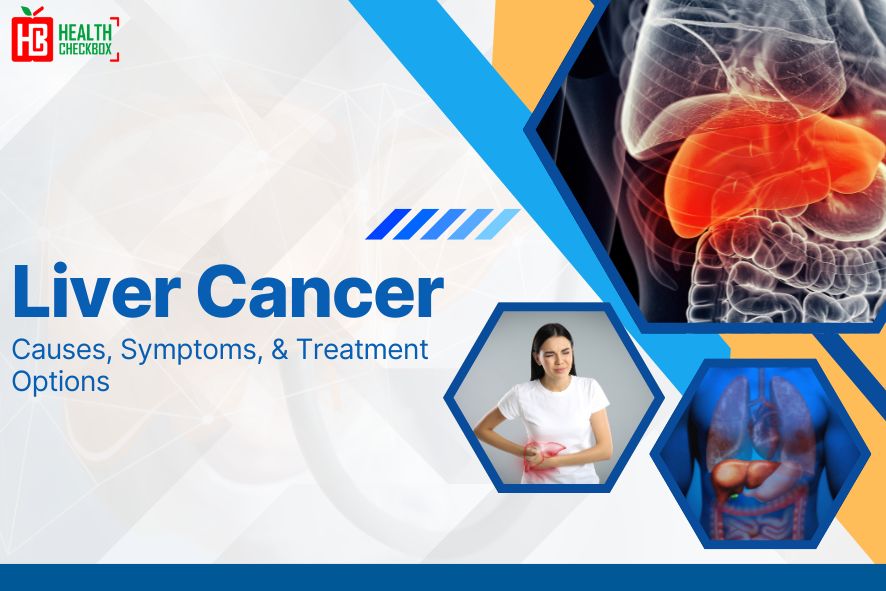Liver cancer is one of the fastest-growing cancers in the world. There are multiple causes behind liver tumors, which are life-threatening. It is very difficult to find liver cancer symptoms in the early stages because the cancerous cells rarely give any warning signs. So it is very important for people to know about the early warning signs of liver tumors. If they know they can treat themselves on time.
Hepatic cancer is a disease that is caused by uncontrolled liver cells or cancerous cells. This can be a primary or secondary means formed within the liver or transferred from other organs. There are multiple reasons for hepatic cancer, but one of them is overconsumption of alcohol. So in this blog, we will give you information regarding liver cancer symptoms, including differences, risk factors, and treatment options.
What Causes Liver Cancer Symptoms?
The main cause of liver tumor symptoms is a DNA mutation. This problem arises when tumor suppressor genes control cell growth in the body. In this case, the cells grow uncontrollably in the body, which results in cancer. This same case occurs in the liver also, where liver cells grow and die when they get instructions from the infected genes.
Hepatic Cancer Symptoms: Early Signs You Shouldn’t Ignore
Here are some of the early signs of tumors you shouldn’t ignore:
- Jaundice: This is one of the main symptoms of liver disease, in which the color of the skin and eyes turns yellow.
- Pain: The patient feels persistent pain in the body due to tumor formation.
- Fever: Some of the patients get a fever during liver disease.
- Itchy Skin: The skin gets dull and itchy.
- Weight Loss: During liver cancer, patients lose their appetite and feel weak.
- Nausea: This is another symptom in which a person feels that all things are revolving around them.
- Swelling of the Abdomen: Some patients experience swelling in the abdominal area.
- Hard Bumps Below the Ribs: People also feel hard bumps during liver disease.
Difference Between Liver Cancer Symptoms & Other Liver Diseases
Below is the table for liver cancer symptoms & other liver diseases:
| Liver Cancer Symptoms | Other Liver Diseases Symptoms |
| Unexplained weight loss | Fatigue |
| Jaundice | Swelling in the legs |
| Swelling in the abdomen | Dark coloured urine |
| A lump felt under the ribs | Pale coloured stools |
| Persistent pain | Skin problems |
Risk Factors of Liver Cancer
Here are some of the risk factors of liver tumors:
- B/C Hepatitis: The presence of B/C hepatitis can increase the risk of liver tumors. So it is important to get vaccinated for B hepatitis and cure C hepatitis on time.
- Alcohol Consumption: Over or heavy alcohol consumption also leads to liver tumors. It is very important to limit alcohol consumption for those who have a diseased organ.
- Fatness: It is also a factor that increases the chances of liver tumors or fatty liver. It is important to get a healthy liver, lifestyle, and stay away from diseases like organ cancer. Lack of appetite, fatigue, nausea, and swelling are some signs of a fatty liver.
Diagnosis Test for Liver Cancer
Here are some methods used to diagnose liver cancer:
- Physical Examinations: A doctor checks your medical history and symptoms and then performs a physical test.
- Blood Tests
- Liver Function Tests: This test is performed to check for any abnormalities in liver functioning.
- Alpha-Fetoprotein Tests: Doctors check for the AFT levels in the body. If AFT levels are higher than normal, then it’s a sign of liver disease.
- Imaging Tests
- Ultrasound: This is used to check the damaged tissue in the liver.
- CT Scan: This is used to check the size, shape, and location of the tumors.
- MRI Scan: This is used to generate a better image of the tumor so that it can be evaluated perfectly.
Treatment Options for Liver Cancer
For going to a transplantation or treatment, find the best hospitals and the best liver transplant surgeon. Here are some of the famous treatment options available for liver tumors:
- Operation: This is the primary option where doctors remove the infected part from the liver and leave the other half to regenerate on its own.
- Liver Replacement: In liver transplant treatment, doctors replace the diseased liver with a healthier one. In this surgery, finding a donor for a liver transplant is one of the difficult tasks.
- Drug Therapy: These powerful chemotherapy drugs are used to destroy the cancerous cells present in the liver.
- Radiation Therapy: Like X-rays, this radiation therapy also uses powerful radiation to destroy the cancerous cells present in the liver.
Conclusion
Liver disease is a fast-growing disease that can result in cancer sometimes. So it is very important to know the early signs of these diseases. In the primary phase, this is not a big problem, but if not cured on time, it can turn into cancer. In this blog, we covered all the important information regarding liver cancer, and I hope you understand our blog and gain some useful insights from it.

